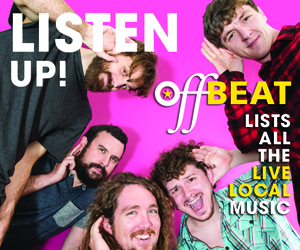I’ve been on a two-week road trip vacation. Here are a few random musical thoughts:
— When radio became too painful, we listened to Rhapsody on my iPhone. I have a few issues with the app, but the experience suggested that we’re not that far from truly being able to go to cloud computing. Even with AT&T, I had 3G coverage deeper into rural areas than I expected.
— Last year, the T-P’s Alison Fensterstock and I were swapping email on the roots and fate of classic rock as a format. I figured that because it was in decline here, it was in decline nationwide. I now know that that’s not the case. It has, however, become the de facto oldies station. A station in the Pensacola area solidified this hunch when it followed four classic rock tunes including Free’s “All Right Now” with the station promo, “The soundtrack of your life,” then Stevie Wonder and Billy Joel. Only a Detroit-based station that played Led Zep and Metallica seemed dedicated to classic rock as a music. As the soundtrack to a drive through the manufacturing belt where anti-Obama bumper stickers and billboards were common sights, it felt like the classic rock stations were fighting a rear guard battle with modernity.
 — In Toronto, it was a pleasant surprise to find late ’70s/early ’80s punk and post-punk still have a lot of currency. Admittedly, it was played in fashion-oriented stores, so it was a part of image construction, but it has yet to be thoroughly digested and maintains its ability to help determine in-crowd/out-crowd. In a hole in the wall bar, we found Generation X on the jukebox, and a Queen Street West store silk-screened retro T-shirts and hoodies including one with the logo from the Stiff Records 1982 American tour.
— In Toronto, it was a pleasant surprise to find late ’70s/early ’80s punk and post-punk still have a lot of currency. Admittedly, it was played in fashion-oriented stores, so it was a part of image construction, but it has yet to be thoroughly digested and maintains its ability to help determine in-crowd/out-crowd. In a hole in the wall bar, we found Generation X on the jukebox, and a Queen Street West store silk-screened retro T-shirts and hoodies including one with the logo from the Stiff Records 1982 American tour.
— Listening to the radio on the drive helped explain the religious passion people from outside New Orleans have for New Orleans music. The overlap of formats, the sounds of stations and the processed sound involved in station IDs, we were always aware of stations as market-driven entities and it was impossible to hear the music outside of that market imperative. The search for something new or new-ish – even a Lady Gaga – was thwarted or short-lived as it was part of a mix for party gladiators on Destin Beach, and I couldn’t help asking myself, “Do I want to be part of this station’s audience?” Even when I wanted to hear a song. Country songs and classic rock songs weren’t songs – they were appeals to demographic groups. And as much as I think New Orleans music is accessible to a broader audience than people assume, at no point could I imagine a local band appearing on one of these stations without sounding neutered or like a horrible mistake.
Of course, it’s music for another demographic – the one that doesn’t see itself in the more common station demographics, and one that probably has a lot of overlap with NPR (though maybe that’s just the road trip talking).




